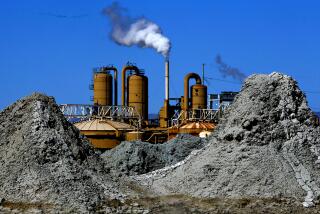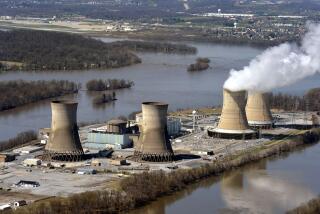Polluted Nuclear Plant May Win 2nd Life
RICHLAND, Wash. â There is probably no more-contaminated place on Earth than this wind-whipped nuclear desert in central Washington, which for 45 years was the plutonium kitchen that fueled much of the U.S. nuclear arsenal.
By the time it shut down production in 1989 and embarked on what would become the nationâs biggest environmental cleanup, the Hanford Nuclear Reservation had accumulated 450 billion gallons of liquid wastes and 200 square miles of contaminated ground water. Leaky underground storage tanks threaten the Columbia River and places downstream with names like Portland, Ore.
Yet in the middle of this massive cleanup effort, the Department of Energy has quietly begun studies aimed at restarting one of Hanfordâs aging test reactors to produce medical isotopes and tritium, a key component of the hydrogen bomb.
The department has halted the planned shutdown of Hanfordâs Fast Flux Test Facility and placed it on âhot standbyâ as a prelude to a final decision later this year.
Officials in nearby Oregon say they are experiencing a nightmarish case of deja vu, contemplating the prospect that Hanford would once again produce poisonous radioactive products. But many in Washington state hail the idea as a chance to breathe new economic life into Hanford.
The issue threatens to unravel the fragile coalition of environmental organizations, local business groups and government leaders in two states that united behind the $2-billion-a-year cleanup program. It also injects a new complication into the nationâs search for a new production source for tritium to restock its aging arsenal of nuclear weapons.
âFundamentally, I think itâs a really bad idea to take a site like Hanford, heavily contaminated, on a cleanup mission, and turn even a part of it back into a production mission,â said Tom Carpenter of the Government Accountability Group, which is opposing a restart of the fast flux reactor. âIt changes the entire culture of the site.â
Hanford watchdog groups have also raised questions about the safety of burning highly enriched plutonium fuel in a reactor never tested for such a configuration, particularly at a time when Hanford is still reeling from a May 14 explosion in a plutonium finishing plant that resulted in the release of waterborne plutonium and exposed eight workers to toxic chemicals. Last week the Energy Department issued a blistering self-criticism, noting that virtually the entire chain of emergency response broke down during the incident.
âThere is a reactor configuration [for the fast flux facility] that could turn into a mini-atomic bomb,â said Denis Hayes, Earth Day founder and executive director of the environmentalist Bullitt Foundation.
Yet the sagebrush-and-tract-house communities of Richland, Kennewick and Pasco that boomed during Hanfordâs Cold War glory days and busted with disarmament see the proposed start-up as generating hundreds of new jobs and the potential for a new biopharmaceutical industry.
âItâll be utilizing a facility that is just sitting there, waiting to be put to death,â said Sam Volpentest of the Tri-Cities Industrial Development Council, which is pushing for restart of the reactor.
Volpentest says he believes Energy Department officials, who say there is no accident scenario under which the fast flux reactor would blow up like a bomb. âIâm only 92 years old,â he said. âIâve been here half my life. If I was afraid of it, Iâd move back over to Seattle, and who knows what would happen to me over there.â
The small reactor was launched in 1982 as a model test facility for the nationâs up-and-coming breeder reactor program, which would generate more nuclear fuel than it would consume. Cooled with sodium instead of water, it is the only liquid metal reactor in the Nuclear Regulatory Commission cadre. For 10 years, it produced enriched uranium and experimental isotopes, then was shut down with the cancellation of the breeder reactor program in 1992.
Technicians were within hours of draining the liquid sodium for what would essentially be permanent deactivation when Washington stateâs congressional delegation prevailed on then-Energy Secretary Hazel OâLeary to save it. She issued an order in January to maintain it on âhot standbyâ while the department conducts studies to see if it could serve as a backup or interim source of tritium, along with medical isotopes.
Officially, the department made it clear last year that it didnât consider Hanfordâs small tritium production capability--only about 1.5 kilograms a year, if kept within levels which are safe and which would allow medical isotopes to be produced concurrently--to be a feasible way of meeting the anticipated demand for tritium over the next half century, especially in light of potential safety concerns.
Tritium, a radioactive gas that boosts the explosive power of the hydrogen bomb, has a relatively short half-life of about 12.3 years, requiring about 5% of the amount on hand to be replaced each year to maintain the current inventory.
The U.S. has not produced tritium since 1988, when the last tritium production reactor was shut down at the Energy Departmentâs Savannah River Site in South Carolina. Tritium scavenged from other nuclear weapons retired from the nationâs arsenal has made up the shortfall so far; however, officials estimate that they will need a guaranteed new supply of tritium within the next 10 to 15 years to maintain the stockpile.
The Energy Department last year decided to focus on three tritium alternatives: construction of a linear accelerator, purchasing a commercial reactor or contracting with a utility to produce tritium at an existing reactor.
All the alternatives have their drawbacks. The accelerator could cost anywhere from $4.5 billion to $12.5 billion; commercial reactor use would face substantial political opposition and flout a long-standing U.S. policy against using commercial nuclear technology for military purposes.
Further complicating the equation is the uncertain prospect of future arms-reduction treaties with Russia, which could dramatically reduce the future need for tritium, conceivably so low that even the relatively small quantities that could be produced at Hanford might suffice.
Opponents say restarting the reactor makes no sense when there may be a substantially reduced need for tritium in the future. âMy hunch is that the current projections [of tritium needs] are greatly accelerated,â said Lynne Stembridge of the Hanford Education Action League.
The Hanford reactor might well have gone into full shutdown last year but for the efforts of a small start-up company in Kennewick. Advanced Nuclear Medical Services saw a way to turn the aging test reactor into a big moneymaker, producing tritium for the government and, eventually, medical isotopes for the private sector in what company officials promise would become a new âmedical meccaâ in central Washington.
The idea quickly caught fire in a community that has lost 6,000 jobs at Hanford in the last two years alone. Company president William Stokes, with the enthusiastic backing of local leaders, appeared on a radio talk show hosted by Hugh Rodham, brother of First Lady Hillary Rodham Clinton, with a plan to privatize the reactor.
Stokes saw the plan as irresistible: He and his investors would put up $450 million to take over the reactor. They would produce tritium for the government until a market could be developed for medical isotopes, then begin producing enough isotopes to attract a new biopharmaceutical industry.
He and his partners, he claimed, could produce tritium cheaper than the government could and could allow the government to delay investment in tritium production elsewhere.
The Energy Department last week officially rejected the companyâs privatization proposal, labeling it âpremature.â But the department, previously skeptical about producing anything but tritium at the fast flux reactor, has in recent weeks become an enthusiastic supporter of the isotope idea, pledging that medical isotopes will be included in any restart mission approved at Hanford.
âWeâre absolutely serious about it. The first core has three spaces assigned to it for medical isotopes,â said Ernest J. Hughes, director of the departmentâs fast flux test facility standby project office.
The Pacific Northwest National Laboratory already has been producing isotopes from Hanford nuclear waste and supplying material for about 20 different research programs and clinical trials across the country.
These new-generation isotopes are designed to attach themselves to a delivery molecule within the body and attack specific cancer cells, rather than bathing cancer-free tissue in radiation as normal radiation therapy does. The short-lived isotopes then decay within the body.
In one trial in Texas, 80% of the Hodgkinâs lymphoma patients who had not improved with chemotherapy responded favorably to the isotopes.
Until now, the U.S. has had to rely on Canada for the vast majority of its medical isotopes. Researchers at the Pacific Northwest National Laboratory say restart of the fast flux test reactor, along with other Energy Department projects now underway, would give the U.S. a badly needed domestic capability.
âThere are not a whole lot of reactors around the U.S. that can make these isotopes. In fact, itâs very, very difficult,â said Thomas Tenforde, chief scientist on the isotope program at Hanford. âFor at least a dozen different isotopes, there are no other sources than [the fast flux reactor] that can produce them in the quality and quantity that people are looking for.â
Still, opponents of restarting the reactor believe that medical isotopes are a cover for what the government and potential investors really want: tritium.
âThe so-called medical mission was an obscene cover, a facade, to be able to secure the contract for [the fast flux reactor],â said Randall Bonebrake, a former ANMS employee who had a falling out with the company and was subsequently arrested for allegedly stealing company documents. âI mean, 15 years down the road perhaps they might start doing medical isotope production. However, these are businessmen, and their bottom line is profit.â
Stokes admits that it is tritium that will cover any initial investment in restarting the reactor, but he insists that a lucrative market can be developed for isotopes over the next 10 years. âIf we had the money to run the reactor just to support cancer research, and not the tritium, weâd do that in a minute,â he said.
Opponents of the restart say the debate over tritium versus isotopes obscures the larger questions of diverting money from cleanup to production--maintaining hot standby status drains $31 million a year from cleanup funds--and the issue of whether tritium production can be done safely.
Gerald Pollet, director of the watchdog group Heart of America Northwest, and others have obtained internal memorandums from the Energy Department raising questions about whether the fast flux reactor can safely be operated using heavy concentrations of plutonium fuel, an operation never before tested in the reactor. In some scenarios, a department memo suggests, âthere is no way to avoid having one of two severe accident vulnerabilities.â
However, department officials say the reactor can operate quite safely at low levels of tritium production, below 1.5 kilograms a year. And even in the worst conceivable accident, they say, there would be no bomb-like explosion, and any radioactivity would be contained within the carbon steel dome overlying the reactor core.
Far from adding to the radiation mess at Hanford, says Walter Apley, director of the Pacific Northwest National Laboratoryâs fast flux standby office, the reactor operates at much lower pressure levels than most commercial reactors and would have the advantage of burning plutonium presently stockpiled elsewhere as fuel.
Its waste stream, he says, is tiny by normal reactor standards: about 1,000 gallons of liquid low-level waste and 55 cubic yards of solid low-level waste each year.
âItâs the single safest reactor ever built in the world,â said Darrell R. Fisher, a staff scientist at the national laboratory. âItâs the cleanest, with the least emissions. It has the lowest worker exposure to radiation. Itâs a marvel of engineering.â
More to Read
Sign up for Essential California
The most important California stories and recommendations in your inbox every morning.
You may occasionally receive promotional content from the Los Angeles Times.










